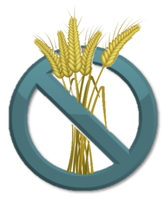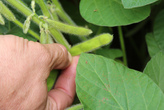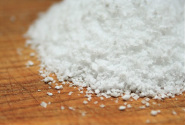
STAY AWAY FROM SUGAR
Did you know that one 20 oz bottle of soda has the same amount of sugar as eleven servings of strawberries, but without the filling quality of those fruits?
Sugar is not something that can or should be completely cut out of a diet, but since it’s found naturally almost everywhere, added sugar is unnecessary and potentially very harmful!
READ FULL BLOG HERE
Did you know that one 20 oz bottle of soda has the same amount of sugar as eleven servings of strawberries, but without the filling quality of those fruits?
Sugar is not something that can or should be completely cut out of a diet, but since it’s found naturally almost everywhere, added sugar is unnecessary and potentially very harmful!
READ FULL BLOG HERE
THE PERILS OF WHEAT

When it comes to things that we, humans, are not adapted to eat and digest, wheat and its gluten protein is probably at the top of the list. Wheat raises blood sugar levels, causes immunoreactive problems, inhibits the absorption of important minerals and aggravates our intestines.
And much of this may stem from the fact that wheat simply ain't what it used to be.
Reasons to Go Wheat-Free / Gluten-Free
First off, let's define the difference. The term "gluten" is popping up everywhere, and the topic can be downright confusing at times. The terms "wheat" and "gluten" are often used interchangeably, but they are not the same thing. Gluten is a protein that is found in wheat, barley and rye. While all wheat contains gluten, not all gluten comes from wheat.
A wheat free / gluten-free diet isn’t just for those with celiac disease or a wheat allergy. Although eating wheat products, especially whole wheat, does offer some health benefits, the gluten can actually be harmful. Here are some reasons you may want to go gluten-free.
And much of this may stem from the fact that wheat simply ain't what it used to be.
Reasons to Go Wheat-Free / Gluten-Free
First off, let's define the difference. The term "gluten" is popping up everywhere, and the topic can be downright confusing at times. The terms "wheat" and "gluten" are often used interchangeably, but they are not the same thing. Gluten is a protein that is found in wheat, barley and rye. While all wheat contains gluten, not all gluten comes from wheat.
A wheat free / gluten-free diet isn’t just for those with celiac disease or a wheat allergy. Although eating wheat products, especially whole wheat, does offer some health benefits, the gluten can actually be harmful. Here are some reasons you may want to go gluten-free.
- Humans don’t fully digest wheat. The undigested portions of wheat begin to ferment, producing gas. Icky, belchable, fart-forming gas.
- Wheat is a pro-inflammatory agent. A pro-inflammatory agent is rapidly converted to sugar, causing a rise in the body’s insulin levels, causing a burst of inflammation at the cellular level, among other problems.
- Wheat can cause leaky gut syndrome. Leaky gut syndrome is a condition whereby stuff is leaking from your gut into your bloodstream — stuff that shouldn’t be there, such as toxins.
- Refined wheat has little nutritional value. Did you know that manufacturers actually have to enrich refined wheat because they’ve taken out all the nutrients? And even then, the wheat’s not that valuable, nutritionally speaking.
- Wheat is one of the top-eight allergens. Millions of people are allergic to wheat — so many, in fact, that it has made it onto the top-eight allergen list.
SOY WATCH

Lately, it seems like everyone I know is dealing with some kind of illness, food allergy, or chronic condition, me included. But I didn’t imagine that there could be health problems associated with something as harmless sounding as soy. I recently read a book called The Whole Soy Story, written by Dr. Kaayla T. Daniel, which talks about the negative effects of processed soy on our bodies (thyroid disorders, immune system impairment, potentially fatal food allergies, digestive distress, etc.), and it called a lot of my previously held beliefs into question
Like many of us, I was taught that whole soy foods could be a source of good protein that promotes health. But after digging a little deeper, not only have I’ve learned that good human studies on soy are limited, but a disturbing number of safety issues surrounding soy have yet to be resolved. In short, soy may not the miracle food we’ve been lead to believe it is; which compels me to suggest the following:
• Just say NO to processed soy. That includes genetically engineered soy foods, soy supplements, and soy junk foods like soy cheese, soy ice cream, soy oil, and soy burgers.
• If you must eat soy, eat only organic soy.
• Replace soy oil with olive oil, fish oil, nuts, and seeds.
Although each of us is unique and, ideally, diets should be individualized, the most effective, long-term road to vibrant health comes from doing your research and listening to your own body. But while the jury is still out on soy, isn’t it better to avoid a potentially harmful food source whenever possible?
Resources: The Whole Soy Story, Kaayla T. Daniel, PhD, CCN; (New Trends Publishing, 3/05).
Like many of us, I was taught that whole soy foods could be a source of good protein that promotes health. But after digging a little deeper, not only have I’ve learned that good human studies on soy are limited, but a disturbing number of safety issues surrounding soy have yet to be resolved. In short, soy may not the miracle food we’ve been lead to believe it is; which compels me to suggest the following:
• Just say NO to processed soy. That includes genetically engineered soy foods, soy supplements, and soy junk foods like soy cheese, soy ice cream, soy oil, and soy burgers.
• If you must eat soy, eat only organic soy.
• Replace soy oil with olive oil, fish oil, nuts, and seeds.
Although each of us is unique and, ideally, diets should be individualized, the most effective, long-term road to vibrant health comes from doing your research and listening to your own body. But while the jury is still out on soy, isn’t it better to avoid a potentially harmful food source whenever possible?
Resources: The Whole Soy Story, Kaayla T. Daniel, PhD, CCN; (New Trends Publishing, 3/05).
SUGAR - THE DARK SIDE

Most adults eat way too much sugar. Sugar is found naturally in many foods, such as honey and fruit. However, it's also added to lots of foods - most obviously sweets, chocolate and cakes. There are also 'hidden' sugars in things like cereals and pasta sauces.
To spot hidden sugar, the Health Team recommends getting into the habit of reading nutritional information listed on food. Look for the 'carbohydrates (of which sugars)' figure. 15g or more of sugar per 100g is a lot and 5g or less is a little. When the carbohydrates aren't broken down into sugars, have a look at the ingredients list. The main ingredient comes first. Look out for other words that are used to describe sugar, such as sucrose, glucose, fructose, invert sugar and corn syrup. If one of these is near the top of the list then that product is probably high in added sugar.
If you are trying to lose weight the obvious way to do it is by cutting out sugars. Here are a few other reasons why you should avoid sugars:
Resources: The Health Team: http://www.wellsphere.com/health-team-profile/94520
To spot hidden sugar, the Health Team recommends getting into the habit of reading nutritional information listed on food. Look for the 'carbohydrates (of which sugars)' figure. 15g or more of sugar per 100g is a lot and 5g or less is a little. When the carbohydrates aren't broken down into sugars, have a look at the ingredients list. The main ingredient comes first. Look out for other words that are used to describe sugar, such as sucrose, glucose, fructose, invert sugar and corn syrup. If one of these is near the top of the list then that product is probably high in added sugar.
If you are trying to lose weight the obvious way to do it is by cutting out sugars. Here are a few other reasons why you should avoid sugars:
- Sugar stimulates the pancreas and adrenal glands that produce Cortisol (a stress hormone which is linked to weight gain)
- Sugar has been shown to suppress the immune system and slows the metabolism
- Sugar is acidic to the body
- It creates favorable conditions for bacteria and viruses to grow and feeds candida, fungi and diseased cells
- Sugar has been shown to induce swelling, cause bloating and provokes allergic responses
- It leads to premature aging (wrinkles) and causes dental decay
- Sugar leads to Constipation !!
Resources: The Health Team: http://www.wellsphere.com/health-team-profile/94520
MSG WATCH

Like you, I’ve known for a long time that Monosodium Glutamate, or MSG, was a food additive to be avoided. But research has shown that MSG, found in many popular snack foods, actually causes weight gain and obesity by damaging the appetite regulation center of our brains known as the hypothalamus, shutting down our ability to feel full. Worse, it creates a drug-like high that gives us a sense of false well being, literally turning us into junk-food junkies and enticing us to overeat!
Many processed food manufacturers know that when consumers become aware of the dangers of MSG, they no longer want to buy products that contain it. So companies often go to extremes to hide MSG in their products, a practice that has been historically tolerated by the FDA.
In her horrifying and empowering article, The Dangers of MSG, Barbara L. Minton educates us on the many dangers of this toxin and provides a helpful list of common foods containing MSG, as well as the following list of MSG aliases: hydrolyzed vegetable protein, autolyzed vegetable protein, textured vegetable protein, hydrolyzed yeast extract, autolyzed yeast extract, plant protein extract, sodium caseinate, calcium caseinate, yeast extract, textured whey protein, and textured soy protein.
Resources:
http://www.msgmyth.com/hidename.htm
www.naturalnews.com
www.foodmatters.tv
http://www.ehow.com/info_7912004_msg-food-list.html
Many processed food manufacturers know that when consumers become aware of the dangers of MSG, they no longer want to buy products that contain it. So companies often go to extremes to hide MSG in their products, a practice that has been historically tolerated by the FDA.
In her horrifying and empowering article, The Dangers of MSG, Barbara L. Minton educates us on the many dangers of this toxin and provides a helpful list of common foods containing MSG, as well as the following list of MSG aliases: hydrolyzed vegetable protein, autolyzed vegetable protein, textured vegetable protein, hydrolyzed yeast extract, autolyzed yeast extract, plant protein extract, sodium caseinate, calcium caseinate, yeast extract, textured whey protein, and textured soy protein.
Resources:
http://www.msgmyth.com/hidename.htm
www.naturalnews.com
www.foodmatters.tv
http://www.ehow.com/info_7912004_msg-food-list.html
SALT: HOW MUCH IS TOO MUCH?

The American Heart Association recommends that adults who are healthy take in no more than 2,300 milligrams of sodium a day, but I strongly believe that most of us consume much more salt than that. Cutting back on salt is crucial to maintaining healthy blood pressure. Limit your salt intake to 1,500 mg per day with these helpful tips:
• Cut back on salty snack foods like potato chips and pretzels.
• Stay the heck away from fast food outlets.
• Read the label. Look for low-salt or reduced sodium products.
• Replace canned vegetables with fresh steamed or raw vegetables.
• Use herbs and spices like garlic powder, thyme, and basil to flavor your foods instead of reaching for the saltshaker.
Resources:Archives of internal medicine, 170 (8), 732-4 PMID: 20421561
